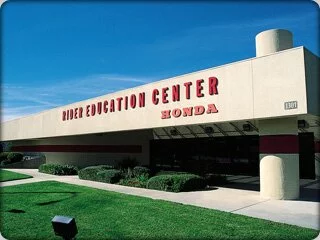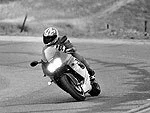Rookie Rider
 In regards to cars and race tracks, I have a fair amount of experience. In fact, my second time driving a manual transmission, I drove a Days of Thunder movie car at the Lowes Motor Speedway. Since then, I have driven street cars, NASCAR stock cars, open wheel racecars, and Grand Touring racecars on tracks like Sebring, Road Atlanta, Virginia International Raceway, Las Vegas Motor Speedway, Atlanta Motor Speedway, Portland International Raceway, and Circuit Mont-Tremblant in Canada. If you couldnt already tell, I am comfortable on four wheels at speed.
In regards to cars and race tracks, I have a fair amount of experience. In fact, my second time driving a manual transmission, I drove a Days of Thunder movie car at the Lowes Motor Speedway. Since then, I have driven street cars, NASCAR stock cars, open wheel racecars, and Grand Touring racecars on tracks like Sebring, Road Atlanta, Virginia International Raceway, Las Vegas Motor Speedway, Atlanta Motor Speedway, Portland International Raceway, and Circuit Mont-Tremblant in Canada. If you couldnt already tell, I am comfortable on four wheels at speed.
However, when it comes to motorcycles, they scare the living daylights out of me. Well, I should say they use to, because I recently caught the fever to start riding. This fever was brought on by two reasons: one, because as a bicycle rider, I could only image how much more freedom motorcycle riders have, and two, because the babes tend to love motorcycle riders. Having visions of sizzling Bettys clinging to ones backside on a bike can help anyone put aside the fear of crashing and burning. If you too have been bitten by the bug, then check out this series on learning to ride.
Long before helmets, leather jackets, boots, or the bike itself are bought, attendance at a motorcycle riding course is mandatory. Well, its mandatory if you want to learn to ride the proper way and to learn techniques that could save your life. These courses will also help raise the overall level of enjoyment of riding a motorcycle. Dont get it twisted though, because both experienced riders and novices like me can and will benefit from these courses.
These courses are an excellent way for riders to learn the four basic skills necessary to ride a bike, i.e. straight-line riding, shifting, stopping and cornering/turning. It also introduces the student to strategies so that they will know how to handle many of the situations that they will encounter on the street. Donna Fisher, motorcycle riding instructor.
Most courses are conducted over three days and take place on weekends. The cost for these courses can range anywhere from $125 to $190. These charges include the use of a helmet and the use of the schools motorcycles. Our course started on a Friday evening with an introduction to your classmates, an explanation as to why they were attending the course, and a text book introduction to the controls of a motorcycle. One of the best testimonies for attending the class came from Steve Elliot, who had recently had a serious accident the first time he rode his bike.
Steve had just picked up his new Harley Davidson from the dealer and was headed for an empty parking lot to get accustomed to his new ride. Another motorcycle was parked on the side of the road, in his path, but was obscured from view by a dumpster. When it did become visible, Steve attempted to swerve and accelerate around it. Steve recalled, My first mistake was not respecting how powerful and fast Harleys are. Before the accident, I thought that only crotch rocket sports bikes were fast and that Harleys were slow. The combination of loose gravel, the sudden change in direction and too much throttle input ended in a crash. Steves accident left him with five broken ribs, a broken shoulder blade, a broken collar bone, and a punctured lung. I have been an adrenaline junky all my life enjoying high risk activities like scuba diving and parachute jumping. The difference is that I approached them with a level of respect. There is a certain amount of accepted risk for each sport that we participate in, but a reasonable person will try to reduce the risks by approaching these activities thoughtfully. Steve claimed.
The class was bunched in small groups to read over written material pertaining to the motorcycle itself, riding techniques, accident avoidance, and overall safety. This information and group questions were then reviewed by the class together. The class was then forced to watch several videos that must have been produced in Wisconsin because they contained plenty of cheese. While the execution of the videos was pretty bad, the sum of their content was well worth the time. Throughout the evening and the following day, the deadly dangers of motorcycles was brought up and reinforced again and again and again.
Riding instructor Donna Fisher, revealed, Two predominate causes that are often sited for accidents involving novice/uneducated riders are situations where they run wide in curves and are unable to swerve or stop effectively to avoid objects. These issues were addressed in the course materials. Consequently, while the morbid videos may have seemed counter-productive, statistics show that motorcycle accidents tend to happen when riders become complacent or overconfident.
Day two started bright and early when everyone was introduced to their new training steed. Although some had never been on a motorcycle, simply being familiar with where the key controls are made a difference. We began by learning how to start the motorcycles and how to ride while using our legs to keep balance. By lunch, we had progressed to a faster pace, with both feet on the pegs. The riding lessons consisted of changing gears, stopping quickly but smoothly, making wide fast turns, and maneuvering the bike through tight slow speed turns.
Both Steve and Robin Grubb attended three day riding courses to improve their riding skills and to become safer bikers. It was Robin who took the course first; a few months before her husband. Riding classes should be mandatory for all motorists, riders, and drivers alike. These courses will open your eyes to many safety concerns that most riders and especially drivers are not aware of. Drivers should take the course because it would give a much higher level of respect for riders. She then went on to explain how the course saved her from serious injury during a ride.
The incident happened during a run up to Pilot Mountain in North Carolina with a local Hog chapter. Robin had a little over 1,000 miles under her belt when she took this trip, so she wasnt an inexperienced rider. As she was taking the last switch back curve just before reaching the top, the frame work upon which her running boards were attached caught the asphalt. In an instant, the lesson on not braking while leaning or turning flashed in my mind. So I brought the bike back to an upright position and brought it to a stop in a controlled manner just as they had taught me, Robin
remembered.
Like Robin, her husband Steve also had biking experience, primarily off-road, before taking the class. After she had taken the course, she constantly preached to me that I needed to take the class, and after her near accident, her preaching hit home, Steve Grubb remarked, when riding a motorcycle, your vision is one of, if not the most important, safety elements for a biker. The course made me aware of many safety concerns that I wasnt aware of before, one of which was looking ahead. Now I am more observant of things that are in front of me, which allows me to react quickly and safely, said Steve.
Everyone walked away from the course with a new respect for motorcycle riding. They also came away with better skills and will enjoy riding more than ever. I think that the better you get at what you do, the more comfortable you will be doing them, which translates to more enjoyable rides, Donna Fisher proclaimed.
Last but not least, if you pass one of these three-day courses, you will not have to take a road evaluation test at the DMV. In addition, most insurance companies will give you a 10% to 20% discount on your policy. If these benefits are not enough to convince you to take a rider course, I suggest that you read this article again.
By the way, if you are a hip-hop music fan, you probably know what the letters RR represent when on a motorcycle. The term Ruff Ryders was made largely popular by rap artist DMX, but it is also the name of the record label that first signed him. However, when you see RR on my Honda CBR F4i, it represents Rookie Rider. Um, um excuse me, Rookie Ryder
..ya heard!
(this article was taken from speedtv.com)
GT on 11.08.05 @ 10:30 AM GMT [link]









 Yamaha Motor Co. has released its second electric vehicle (EV) model, an under-50cc motorbike powered solely by electricity. The new model is called the "Yamaha Electric Commuter EC-02."
Yamaha Motor Co. has released its second electric vehicle (EV) model, an under-50cc motorbike powered solely by electricity. The new model is called the "Yamaha Electric Commuter EC-02." In regards to cars and race tracks, I have a fair amount of experience. In fact, my second time driving a manual transmission, I drove a Days of Thunder movie car at the Lowes Motor Speedway. Since then, I have driven street cars, NASCAR stock cars, open wheel racecars, and Grand Touring racecars on tracks like Sebring, Road Atlanta, Virginia International Raceway, Las Vegas Motor Speedway, Atlanta Motor Speedway, Portland International Raceway, and Circuit Mont-Tremblant in Canada. If you couldnt already tell, I am comfortable on four wheels at speed.
In regards to cars and race tracks, I have a fair amount of experience. In fact, my second time driving a manual transmission, I drove a Days of Thunder movie car at the Lowes Motor Speedway. Since then, I have driven street cars, NASCAR stock cars, open wheel racecars, and Grand Touring racecars on tracks like Sebring, Road Atlanta, Virginia International Raceway, Las Vegas Motor Speedway, Atlanta Motor Speedway, Portland International Raceway, and Circuit Mont-Tremblant in Canada. If you couldnt already tell, I am comfortable on four wheels at speed. The biggest trap inexperienced motorcyclists fall into is not practicing good visual skills. This is probably the single largest cause of accidents for novice riders, yet it is also the most basic skill that forms the foundation for every control action you perform while riding.
The biggest trap inexperienced motorcyclists fall into is not practicing good visual skills. This is probably the single largest cause of accidents for novice riders, yet it is also the most basic skill that forms the foundation for every control action you perform while riding.